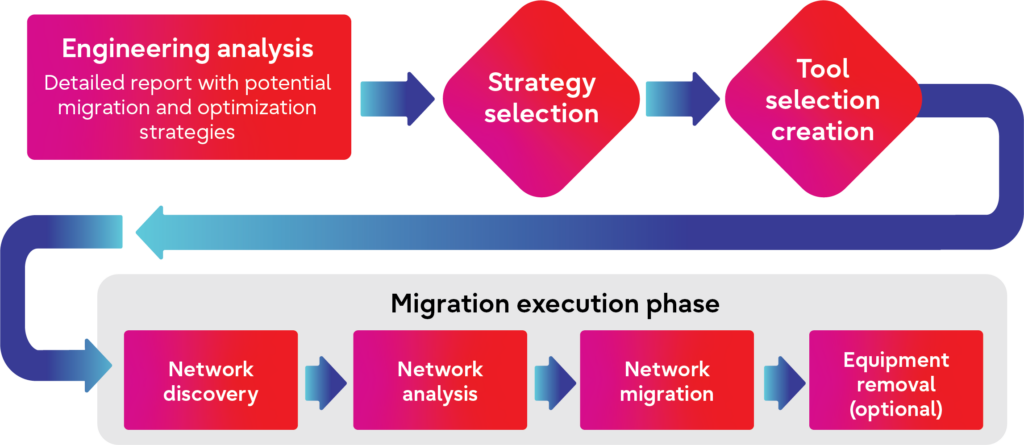
Site exit/consolidation can be found money for service providers
With revenue growth flattening over the last few years, wireless and wireline service providers are intensifying their focus on cutting costs. From using C-RAN to reduce network complexity to leveraging AI applications for accelerating decisions, everything is on the table. While the technologies that enable capabilities like C-RAN and AI are gaining a lot of attention (and rightly so), low-hanging fruit can still be found in some old familiar places. As the trend toward network modernization and sustainability continue, many service providers are discovering the value of site exit/consolidation.
What’s driving the decision to try site exit/consolidation?
Many service providers who have successfully weathered the market’s ups and downs have done so through acquisition. In the process, they have acquired a range of Central Office (CO) assets (including facilities, equipment and circuits) that, over time, have become outdated, redundant, or both. Operators are spending precious dollars from Operating Expenses (OpEx) on housing, powering, and maintaining these assets. Consolidating or exiting non-essential or under-performing locations not only reduces the network’s OpEx spend, but in many cases, it can become found money.
Many, but not all site exit/consolidation decisions are part of an overall network modernization initiative, as service providers continue to replace legacy TDM/SONET technologies with modern packet-switched systems. While these legacy network elements are still passing traffic, they are no longer supported by the manufacturer, making spares difficult to find and increasing the risk of outages. As a result, the overall cost to operate these legacy networks begins to outweigh the amount of revenue they generate.
Common reasons for a site exit/consolidation
- Eliminate unnecessary costs
- Consequence of a real estate decision (i.e., the building is sold, or the lease not renewed)
- Site exit/consolidation is needed to meet sustainability goals or emissions compliance
- The decision is made as part of a larger system-wide network modernization strategy
- Site exit/consolidation as part of a localized network consolidation effort.
Another major driver of site exit/consolidation is the need to optimize real estate investments. Real estate leasing costs often represent a significant portion of a company’s OpEx budget. As square-foot rental costs for prime locations in key markets continue to increase, CFOs and CIOs are taking a hard look at redeploying equipment to increase the bang for their real-estate bucks.
Corporate sustainability initiatives are also playing an important role as operators pare down their operating footprint. Consolidating or closing locations enables them to reduce overall power consumption, use of consumables, and the associated environmental impact of truck rolls for repair and maintenance.
Benefits of site exit/consolidation
If the decision to vacate or consolidate a CO is purely business-driven, the key benefits are based on ROI and its various multipliers. Among these is the gray market value of decommissioned modules, older cards (some which contain gold and other precious metals), and even scrap copper cabling. Some site exit providers, including Fujitsu, also offer equipment buy-back programs.

Reducing or eliminating the amount of equipment at a CO also helps decrease the resources and costs of operating and maintaining the overall network. For example, it can result in savings on monthly recurring power expenses for HVAC and equipment, including the cost of battery backup systems. Site exit/consolidation can also significantly reduce the number and management costs of multiple OEM equipment maintenance programs and service contracts, much of which is administrative costs that erode the bottom line.
Freeing up space enables new services turn-up and additional revenue. One opportunity lies in redesigning the central office into a small low-latency edge-based data center and leasing it to data center providers looking for a regional presence. Known as CORD (Central Office Rearchitected as a Data Center), this approach aims to replace older purpose-built hardware with more agile, software-based elements and, in doing so, ensures that legacy carrier COs become an integral part of a larger cloud strategy.[i]
Another key motivator of site exit/consolidation is sustainability. To reach a critical goal of limiting global warming to 1.5°C above pre-industrial levels, it is estimated that the industry must reduce Greenhouse Gas (GHG) emissions by 45% from 2020 to 2030.[ii] This will involve pulling every possible lever, including site exit/consolidation. In addition to contributing to the overall effort to reduce GHG emissions by lowering energy use, this strategy can also pay off in terms of renewable energy credits, power company reimbursements, and reducing the risk of climate legislation penalties.
Lastly, as part of a site exit or consolidation project, service providers will need to reconcile their Operating Support System (OSS) records which, depending on the network, can be large and bloated. The process of reconciling and cleaning the OSS databases can yield enormous value, enhancing the provider’s ability to coordinate customers, services, resources, processes, and activities.
Site exit/consolidation scenarios and process
A site exit/consolidation project, which often includes circuit emulation, can take many forms depending on the objectives driving the move. But they all involve the process of consolidating legacy circuits and equipment within a site or among multiple sites. The following are some of the more common types of site exit/consolidation projects that Fujitsu handles.
- Like for like: Migrating traffic from the legacy sites onto existing like equipment at target sites
- Legacy to next-generation: As part of a larger net-mod strategy, this type of consolidation migrates traffic from the legacy site onto new or existing next-generation equipment at target sites
- Floor consolidation: Migrate traffic from legacy to target floor in the same building, onto like or next-generation equipment
- Cage consolidation: Migrate traffic from legacy cage to target cage, either onto like or next-generation equipment
- Cage compression: Migrate traffic from one system to another in the same cage to reduce square footage used

There are as many ways to implement a migration project as there are scenarios. Fujitsu’s basic process follows a four-step plan:
- Engineering analysis
- Strategy selection
- Tooling
- Migration
a. Network discovery
b. Network analysis
c. Network migration
d. Equipment removal
One of the most undervalued aspects of the project is the tooling needed to automate the complex tasks. The heavy lifting is typically the upfront work needed to audit, inventory, and scrub the databases. Handling these tasks manually isn’t feasible, which means advanced tooling is required.
Often, the tooling needed is specific to the project and needs to be custom written. Fujitsu has an in-house team dedicated to creating custom tools for site exit/consolidation projects. Some tools (like Fujitsu’s proprietary digital annealer) have applications beyond one or two jobs. Fujitsu’s heuristic algorithm, used for migration sequencing in network modernization projects, also has a patent pending.
Potential pitfalls and blind spots
Over the last three decades, Fujitsu networking teams have completed more than 150 network modernization projects involving the migration of well over 1.25 million circuits. Many of those projects required some level of site exit or consolidation. Over that time, we have gained valuable insight into the potential pitfalls and blind spots that can compromise a project.
Understand the big picture: Consolidating traffic, decommissioning a site, or transitioning to packet-switched services will impact network functionality and operations beyond the location(s) in question. Work with your technology partner to understand the true scope of the project and define the best strategy. When it’s time to execute your strategy, implementation can occur sequentially or in parallel.
Demonstrate revenue potential for the freed space: Services like a site exit/consolidation are usually paid for with expense dollars. However, most expense dollars are allocated to projects that support new services. Therefore, combining a site exit with a revenue-generating redeployment of the freed space may have a better chance of getting funded compared to a site exit alone.
Target the C-suite: Typically, the conceptual value of these projects is evident, but the actual cost savings (i.e., facilities, spares, and operations) are spread across multiple divisions or organizations. This dilution can make the project difficult to fund unless it is pitched to those whose job it is to think and plan strategically. Gaining a champion among the decision makers (like the CIO, COO, or CTO) can provide visibility at the right level.
To see how Fujitsu can help you recover valuable OpEx dollars and increase the operating efficiency and capabilities of your network, check out our Site Exit/Consolidation Services page or contact your Fujitsu representative.
[i] Rearchitecting central offices into data centers; Cabling Installation & Maintenance; August 16, 2022
[ii] Telcos and the climate crisis: Solutions for cutting CO2; Fierce Wireless; August 7, 2023